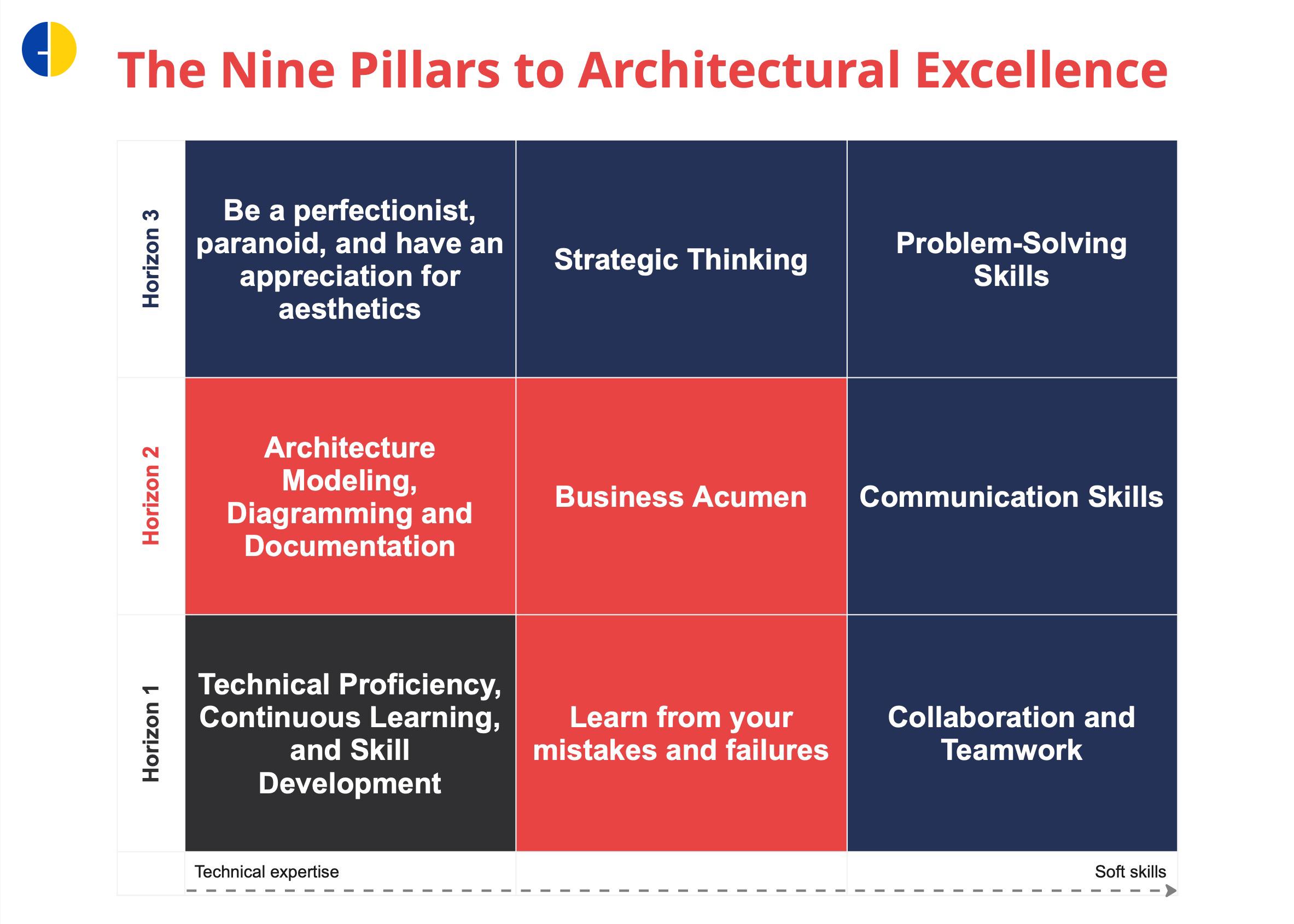Becoming a better Solution Architect involves a mix of technical expertise, soft skills, and continuous improvement. In this blog article, I’ll examine nine things and practices that can help you excel in the Solution Architect role.
This blog post is the second in the series “Mastering the Craft: A Deep Dive into Common Pitfalls for Architects.” The first post was Architectural Red Flags: 10 Mistakes Undermining Solution Architects.
Preface
As a Solution Architect, your role is the bridge between creativity and practicality, transforming complex challenges into intelligent solutions. Embracing continuous improvement isn’t just a choice; it’s the foundation that strengthens your ability to innovate, adapt, and lead in a constantly changing tech world. By aiming for improvement, you’re polishing your skills and nurturing a mindset that thrives on fresh ideas and resilience. Every effort you put into your growth expands the range of possibilities, ensuring your solutions remain cutting-edge, adaptable, and vital to the success of the projects you handle. Remember, in this dynamic field, your dedication to continuous improvement isn’t just a journey; it’s the driving force that pushes you toward being a trailblazer in innovation and excellence in solution architecture.
Let’s use the 3 Horizons model to structure the steps to the Solution Architects’ growth goals. What are the 3 Horizons?
The 3 Horizons represent:
current opportunities,
future opportunities that require more investment (time, effort, experience),
and ideas for future opportunities that can be used as experiments, pilots, or minority stakes in new projects or businesses.

The x-axis represents the focus area (technical expertise and soft skills), but remember that it does not indicate what you should think about now vs. later. You should be thinking about all three horizons at the same time. You will always want to cycle between where you are strong now, which opportunities you believe will be successful in the future, and which opportunities you’d like to explore further.
1. Learn from your mistakes and failures
You need to be able to analyze what went wrong, identify the root causes, and implement corrective actions to prevent or mitigate similar issues in the future.
As Solution Architects, our journey toward excellence isn’t just about the successes we achieve and the valuable lessons we gather from our failures. Mistakes are not roadblocks; they are signposts guiding us toward improvement and innovation. Embracing our failures allows us to dissect and understand what went wrong, enabling us to refine our approaches and solutions. These experiences give us deeper insights, learn what doesn’t work, and discover new paths toward success. By acknowledging and learning from our mistakes, we become better problem solvers and fortify our ability to design more robust and efficient solutions in the future. Every setback is an opportunity for growth, and leveraging these lessons will undoubtedly pave the way for us to excel as Solution Architects.
Ignoring the recommendation to learn from mistakes and failures can have several negative consequences for IT Solution Architects:
Repetition of Errors: Without acknowledging and learning from mistakes, there’s a high likelihood of repeating them. This can lead to a cycle of inefficiency, wasted time, and resources as similar issues resurface in different projects.
Stagnation and Lack of Innovation: Failure to learn from mistakes can result in a stagnant approach to problem-solving. It hampers the ability to innovate and devise novel solutions, hindering professional growth and advancement.
Diminished Trust and Credibility: Continually making the same mistakes can erode trust among team members and stakeholders. It can damage the architect’s credibility, potentially impacting their reputation and opportunities for leadership roles or crucial project responsibilities.
💡 If you haven’t read the first article of this series, “Mastering the Craft: A Deep Dive into Common Pitfalls for Architects,” I welcome you to do it. In the article Architectural Red Flags: 10 Mistakes Undermining Solution Architects. I examined prevalent mistakes made by Solution Architects and offered detailed insights, strategies, and examples to navigate these challenges effectively.
2. Be a perfectionist, paranoid, and have an appreciation for aesthetics
Characteristics like being a perfectionist, paranoid (in a vigilant, cautious sense), and having an appreciation for aesthetics (esthete) have remarkably positive implication for an IT Solution Architect role.
Perfectionist Traits. Being detail-oriented and striving for excellence can result in meticulously designed solutions. It can ensure that the architecture is robust, efficient, and meets high-quality standards.
Paranoia (Vigilance and Caution). A cautious mindset can be beneficial in foreseeing and mitigating potential risks or security threats in the architecture. It could lead to a more resilient system design with built-in contingencies.
Esthete (Appreciation for Aesthetics). Having an eye for aesthetics can result in architecturally pleasing and user-friendly designs. It can contribute to better user adoption and satisfaction with the solutions.
While these characteristics can bring certain advantages, it’s crucial to strike a balance. Utilizing these traits effectively can result in well-crafted, secure, and user-friendly solutions. However, excessive focus on perfection, caution, or aesthetics without considering practicality, innovation, and broader project goals could potentially limit the effectiveness of the architect’s contributions. Therefore, a balanced approach that harnesses the positive aspects of these traits while mitigating their potential downsides is essential in the role of an IT Solution Architect.
🤔 Now, please take a look at these architectural solutions. What do you think? I reckon, it’s evident that traits like perfectionism, paranoia, and an appreciation for aesthetics would never endorse such work.
3. Technical Proficiency, Continuous Learning, and Skill Development
Stay updated with the latest technologies, architectures, and tools relevant to your field. Continuous learning and hands-on experience are crucial for staying at the forefront of technology.
Invest time in continuous learning through courses, certifications, workshops, and hands-on practice.
Keep up with the latest trends and technologies in your domain. You need to know the current and emerging tools, frameworks, methodologies, and platforms to help you design and implement effective and efficient solutions.
Continuously update and refine your skills and knowledge. You need to be proactive in pursuing learning opportunities that can help you enhance your competencies and qualifications. You can also seek certification or accreditation from reputable organizations or institutions that can validate your expertise.
4. Problem-Solving Skills
Develop strong analytical and problem-solving abilities. Develop a problem-solving mindset. Solution Architects face various challenges; being adept at problem-solving and decision-making is crucial for success.
Experiment with different approaches and solutions. You must be creative and innovative in finding the best ways to solve problems and meet challenges. You can also try to apply your skills and knowledge to different domains or contexts that can broaden your perspective and experience.
Problem-solving is critical for IT Solution Architects due to several reasons:
Complexity of Projects: IT Solution Architects deal with intricate technological challenges within projects. They must analyze complex systems, understand diverse requirements, and design comprehensive solutions that address these complexities.
Meeting Business Objectives: Architects must align technological solutions with the overarching business goals. Effective problem-solving ensures that the proposed solutions resolve technical issues and contribute to achieving the business objectives efficiently.
Innovation and Adaptability: Problem-solving drives innovation in the field of technology. Architects must constantly innovate to create functional solutions and incorporate new technologies, methodologies, and best practices.
Optimization and Efficiency: Solutions must be optimized for performance, scalability, security, and cost-effectiveness. Problem-solving skills help architects find the most efficient and effective solutions that meet these criteria.
Risk Mitigation: Architects must foresee risks and issues within a system or project. Effective problem-solving helps identify, analyze, and mitigate risks before they impact the project’s success.
Client Satisfaction: The ability to solve complex problems efficiently and effectively ensures client satisfaction. Clients expect solutions that not only meet their requirements but also surpass their expectations in terms of reliability and usability.
Adapting to Change: In the ever-evolving IT landscape, problem-solving skills allow architects to adapt to new technologies, changing requirements, and unforeseen challenges during the project lifecycle.
💡 To hone your problem-solving skills for Solution Architects, I recommend the book “Technology Strategy Patterns: Architecture as Strategy”.
“Technology Strategy Patterns” is a book offering substantial guidance for IT Strategists and Architects to perform their roles effectively and efficiently. At the core of this work lies the crucial task of choice and roadmap creation. This book meticulously details patterns and their sequential application for devising strategies, specifically from a technological standpoint. It encapsulates patterns that can swiftly guide you through the path: “problem formulation -> analysis (including context) -> synthesis -> validation -> communicating recommendations (including roadmaps).” This resource serves as a comprehensive guide, offering a structured approach that facilitates the development of effective architectural solutions for success in our field.
5. Communication Skills
Effective communication is essential. Develop strong communication skills, both verbal and written. As a Solution Architect, you’ll often need to convey complex technical concepts to various stakeholders with different levels of technical understanding.
Communicate clearly and effectively with your team and other parties involved in the project. You need to be able to articulate your ideas, explain your decisions, solicit feedback, and resolve conflicts in a respectful and collaborative manner.
You must communicate architectural decisions and problems clearly and understandably to technical and non-technical people.
And here I must recommend the book “Illuminate: Ignite Change Through Speeches, Stories, Ceremonies, and Symbols” - one of my absolute favorites. This book is about people, relationships between people in the company, and leaders. It is about leaders who are genuine, brave, and reliable, leading others to change the company or department for the better.
💡 Please read through my overview of the book “Illuminate” by Nancy Duarte and Patt Sanches: Book summary: ‘ILLUMINATE’ by Nancy Duarte and Patt Sanches.
6. Business Acumen
Understand the business needs and objectives thoroughly. Aligning technological solutions with business goals is fundamental to the Solution Architect role. You need to align your solutions with the stakeholders’ vision, needs, expectations, industry standards, and best practices.
For Solution Architects, possessing business acumen is immensely valuable for several reasons:
Aligning Technology with Business Objectives: Solution Architects need to design systems and solutions that align with the business’s overarching goals. Understanding the business context allows architects to create solutions directly contributing to the company’s success.
Cost-Effectiveness and Resource Allocation: Architects with business acumen can make informed decisions regarding resource allocation. They understand the financial implications of different technology choices, optimizing solutions to achieve the best results within budget constraints.
Risk Management: Understanding the business landscape helps architects identify and mitigate risks effectively. They can anticipate potential challenges and align technology choices to minimize disruptions to business operations.
7. Collaboration and Teamwork
Work closely with different teams - developers, designers, managers, and clients. Collaborative skills are essential for successful project outcomes.
Collaborate with other solution architects and professionals in your field. You need to be part of a network or community that can provide support, guidance, resources, and opportunities.
You can also share your insights, experiences, and best practices with others who can benefit from them.
💡 Advice.
Share your projects on GitHub, organize an online community (on Facebook or WhatsApp, whatever), write a blog, make a podcast, etc.
Give and take, - to put it briefly.
8. Strategic Thinking
Develop a strategic mindset to anticipate future needs and design scalable and flexible solutions that can evolve as the business grows or changes.
Strategic thinking empowers IT Solution Architects to go beyond technical expertise, enabling them to envision, plan, and implement solutions that address current challenges and align with the broader organizational strategy. It helps architects be proactive, innovative, and effective in driving technological initiatives that contribute significantly to the business’s success.
9. Architecture Modeling, Diagramming and Documentation
Cultivate the habit of maintaining thorough and well-organized documentation.
Focus on creating clear and comprehensive documentation for your architectural designs. A well-documented architecture helps in understanding, implementation, and future enhancements.
Honing skills like architecture modeling, diagramming, documentation, and using documentation tools can significantly elevate the capabilities of IT Solution Architects in several ways:
Clarity in Communication: Proficiency in architecture modeling and diagramming enables architects to visually represent complex technical concepts, system structures, and relationships. This clarity aids in effective communication with both technical and non-technical stakeholders, ensuring a shared understanding of the architecture.
Improved Decision-Making: Thorough documentation allows architects to outline design decisions, rationale, and dependencies. This comprehensive documentation serves as a reference, aiding in informed decision-making during the project lifecycle.
Enhanced Collaboration: Utilizing documentation tools fosters collaboration among multidisciplinary teams. Shared documentation allows team members to collaborate efficiently, align on design strategies, and contribute to the architectural vision.
Facilitating Knowledge Transfer: Well-documented architectures serve as valuable resources for onboarding new team members. It helps in transferring knowledge about design principles, patterns, and system components, ensuring continuity in project development.
Supporting Compliance and Governance: Comprehensive documentation aids in compliance with industry standards, regulations, and best practices. It enables architects to align the architecture with governance requirements and ensures adherence to established guidelines.
Bonus
Enjoy what you do and have fun. You need to be passionate and enthusiastic about your work and find satisfaction and fulfillment in creating solutions that can positively impact the world.
Conclusion
Remember, Solution Architecture success requires combining technical expertise, soft skills, and a holistic understanding of business objectives. Continuously refining these skills and adapting to evolving technology landscapes will contribute significantly to your professional growth.
Thank you!










